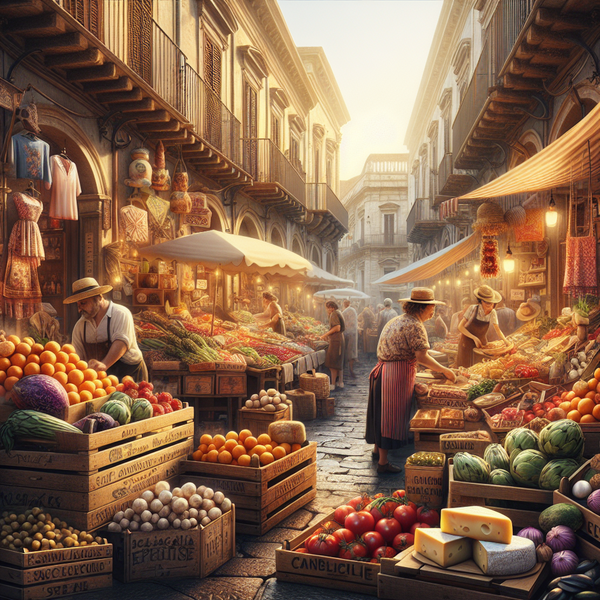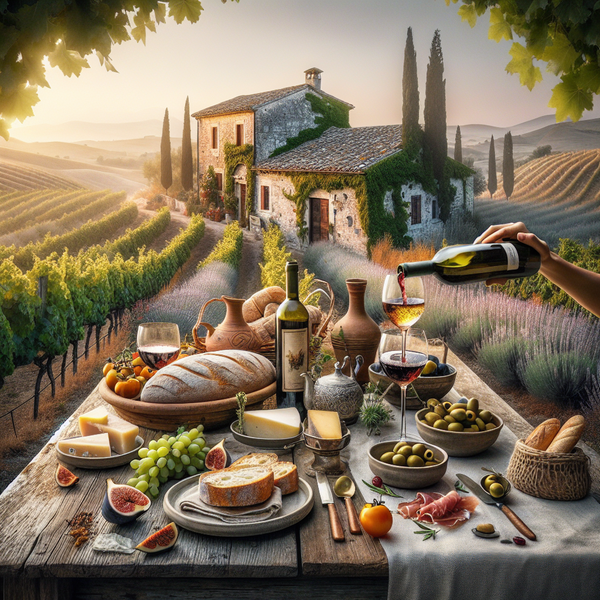Walking through the lively streets of Sicily, it’s almost impossible not to be drawn into the rhythm of its bustling markets. The scents of freshly baked bread, sizzling arancini, and vibrant citrus fruits mix with the colorful displays of handmade ceramics and woven baskets. Sicilian street markets are more than shopping spots—they are an authentic cultural experience where food, tradition, and craftsmanship come together.
Go to the section
TogglePalermo’s Ballarò Street Market for Food and Crafts
Ballarò is one of Sicily’s most iconic street markets, located in the historic heart of Palermo. Known for its electrifying energy, this market offers a wide variety of fresh produce, delicious street food, and authentic crafts. Walking through its narrow alleys, you’ll discover stalls piled high with olives, spices, local cheeses, and handmade Sicilian pottery.
What to Eat at Ballarò Market
The food in Ballarò is a feast for the senses. Typical street-market specialties include:
- Panelle – crispy chickpea fritters
- Arancini – rice balls filled with ragù, cheese, or spinach
- Sfincione – Sicilian-style pizza with tomatoes, onions, and anchovies
- Cannoli – sweet pastries filled with ricotta
Local Crafts to Buy at Ballarò
Besides food, Ballarò is a treasure trove for artisanal crafts. You will find hand-painted ceramics, colorful textiles, and traditional Sicilian puppets—perfect souvenirs that reflect local culture.
Palermo’s Vucciria Market for Food and Handicrafts
The Vucciria Market is another legendary address in Palermo. Though smaller than Ballarò, it holds an undeniable charm. The word “vucciria” means chaos in Sicilian dialect, perfectly describing the mix of scents, sounds, and colors you’ll encounter here.
Why Vucciria is Famous
Vucciria is well known for its seafood. Freshly caught octopus, sardines, and swordfish are laid out on display, ready to be grilled. After sunset, the market transforms into a vibrant hub with street food and lively bars, making it the ideal spot to experience authentic Sicilian nightlife.
Crafts at Vucciria Market
Apart from culinary delights, Vucciria offers handmade jewelry, ceramics, and folkloric crafts. Local artists often sell small, affordable pieces, making it a great place to support Sicilian artisans.
Catania’s La Pescheria Fish Market and Craft Stalls
Located in the heart of Catania, La Pescheria is famous for its atmosphere. The cries of fishmongers, the sparkle of fresh fish, and the lively bartering create an experience that feels timeless. What makes this market unique is its mixture of food stalls and craft vendors.
Food Highlights at La Pescheria in Catania
- Fresh swordfish steaks
- Grilled sardines
- Octopus salad
- Pasta alla Norma with fresh ricotta salata
Beyond fish, you can also find spices, Sicilian olives, capers, and dried fruits. The market is an excellent stop for tasting local flavors right on the spot.
Crafts and Souvenirs at La Pescheria
Artisans also sell vibrant crafts in the nearby alleys. Expect to see handmade lace, colorful ceramics, wooden carvings, and traditional volcanic-stone crafts inspired by nearby Mount Etna.
Ortigia Market in Syracuse for Food and Local Crafts
On the tiny island of Ortigia, part of Syracuse, lies one of Sicily’s most picturesque markets. With its sea breeze, charming streets, and lively stalls, this market offers a mix of culinary treasures and traditional handicrafts.
Food Specialties in Ortigia
The Ortigia market is especially known for seafood such as tuna, sea urchins, and prawns. You’ll also find Sicilian cheeses, sun-dried tomatoes, and pistachios from Bronte. Freshly baked bread and pastries make it the perfect stop to enjoy a quick street-style lunch.
Craft Stalls at Ortigia
Craftsmen sell woven baskets, jewelry made with volcanic lava stones, and handmade leather goods. Shopping here feels like stepping back in time, with artisans continuing traditions passed down through generations.
Ragusa Market for Traditional Food and Artisanal Goods
In Ragusa, the local street markets highlight the region’s agricultural richness. Vendors display fresh vegetables, cheeses, and cured meats alongside a growing scene of artisans.
Food at Ragusa Street Market
Ragusa is renowned for its cheese, particularly caciocavallo ragusano. You’ll also find honey, olive oil, and locally grown herbs. The atmosphere here is more relaxed compared to larger Sicilian markets, yet equally authentic.
Craft Choices in Ragusa
Artisans sell ceramics decorated with traditional motifs, textiles, and items carved from olive wood. It’s the perfect place to pick up meaningful souvenirs directly from the people who craft them.
Trapani Market for Food and Mediterranean Crafts
Trapani’s markets capture the flavors of Western Sicily. Fish, couscous specialties, spices, and traditional pastries reflect the city’s unique cultural mix influenced by North Africa.
Foods You Must Try in Trapani
- Fish couscous flavored with saffron
- Busiate pasta with pesto trapanese
- Almond pastries and nougats
Traditional Crafts of Trapani
Trapani is famous for coral jewelry and intricate salt-based crafts, as the city has long been connected to salt harvesting. These items stand out as some of the most unique artisanal creations in Sicily.
Tips for Visiting Sicilian Street Markets for Food and Crafts
To make the most of Sicily’s vibrant street markets, a few tips can help:
- Arrive early to experience the freshest foods and best picks of the day.
- Try local specialties from street vendors for an authentic Sicilian flavor.
- Haggle politely with artisans when buying crafts—it’s part of the market tradition.
- Bring cash, as many vendors do not accept cards.
- Respect local culture and take the time to chat with vendors—they love to share stories.
Why Sicilian Street Markets for Food and Crafts Are a Must-Visit
Sicilian street markets are not just about shopping—they are a sensory immersion into local life. Whether you’re enjoying the flavors of Palermo’s vibrant alleys, admiring the seafood displays in Catania, or picking handmade crafts in Ragusa, these markets bring Sicily’s culture to life. Visiting them allows you to taste tradition, meet artisans, and take home memories that go beyond material souvenirs.


